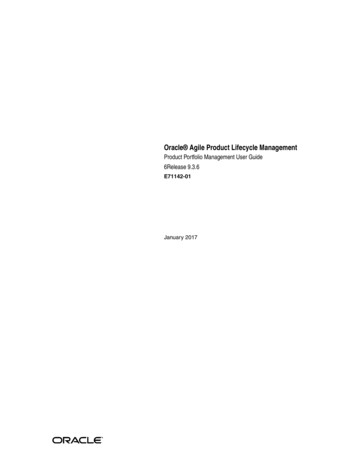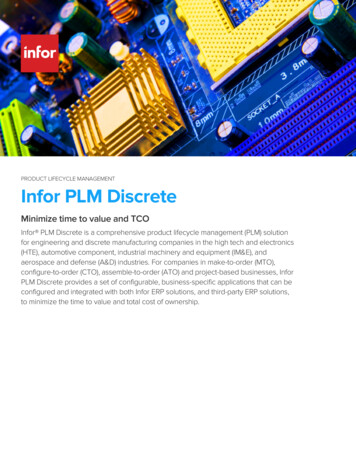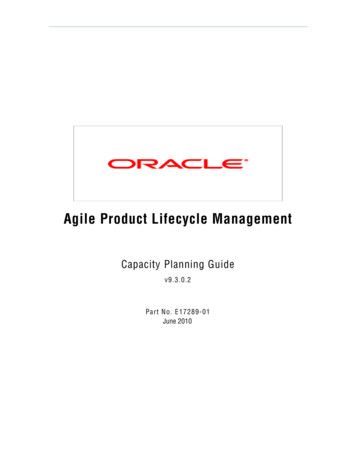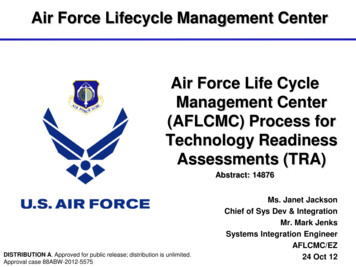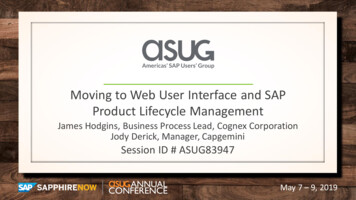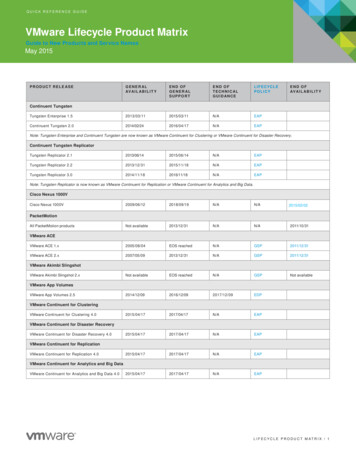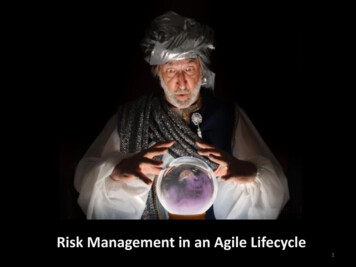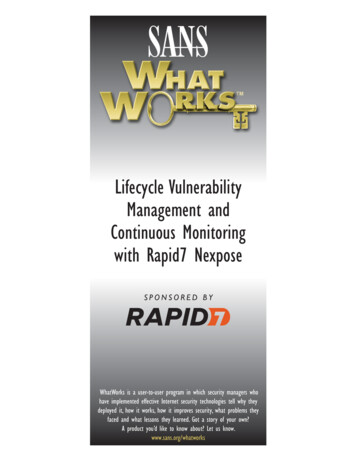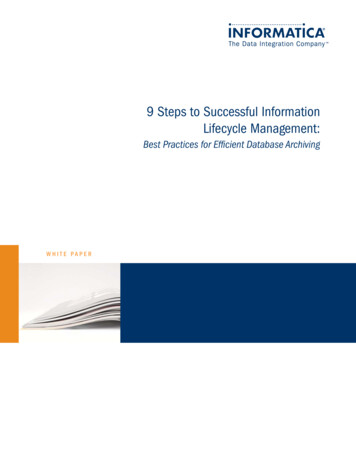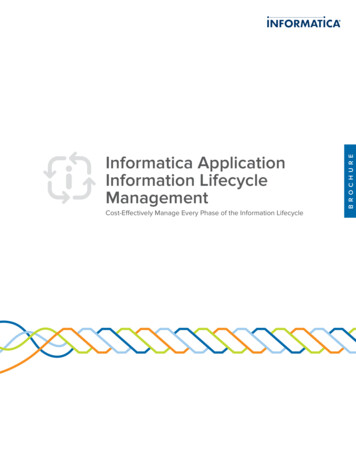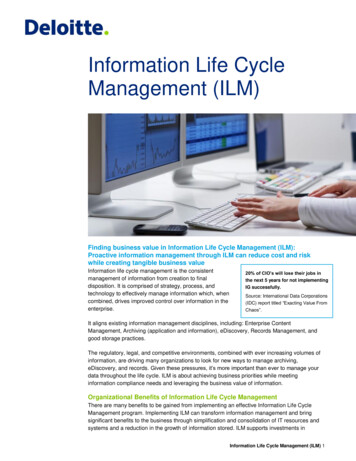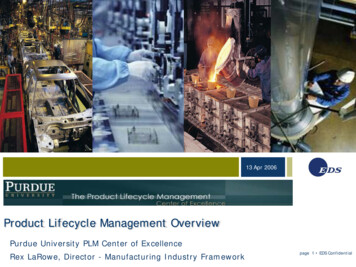
Transcription
13 Apr200603-23-05Product Lifecycle Management OverviewPurdue University PLM Center of ExcellenceRex LaRowe, Director - Manufacturing Industry Frameworkpage 1 EDS Confidential
Agenda Introductions Definition of PLM The Problem EDS’ Approach Suggestions for PLM Center of Excellence DiscussionsEDS Manufacturing13 Apr 2006page 2 EDS Confidential
Product Lifecycle Management (PLM) DefinitionPLM is defined as: A strategic business approach that applies a consistent set of businesssolutions that support the collaborative creation, management,dissemination, and use of product definition information Supporting the extended enterprise (customers, design and supplypartners, etc.) Spanning from concept to end of life of a product or plant Integrating people, processes, business systems, and informationPLM is not a definition of a piece, or pieces of technology.Source: CIMdataEDS Manufacturing13 Apr 2006page 3 EDS Confidential
Fundamental Concepts of PLM Universal, secure, managed access and use of product definitioninformation Maintaining the integrity of that product definition and related informationthroughout the life of the product or plant Managing and maintaining business processes used to create, manage,disseminate, share and use the information.EDS Manufacturing13 Apr 2006page 4 EDS Confidential
The Scope of PLMPlus the engineering businesssystems to make the PD processwork with the Productrest of the companyLifecycleEDS Manufacturing13 Apr 2006page 5 EDS Confidential
The Challenge for PLMEDS Manufacturing13 Apr 2006page 6 EDS Confidential
It has been difficult to document impact of PLM oncompanies financial performanceThis example opportunity and gap analysis identifies the specific operations improvements and associatedopportunities.Financial ngiblesBalanceSheetSourceEDS/A. T. Kearney - ConfidentialEDS ManufacturingOpportunityOperations ImprovementsOne TimeChargesQuality andregulatorycomplianceimprovement30 – 80% Manufacturing standards25 – 65% Cost of Quality (prevention)SalesIncrease in revenue10 – 75% Time to market5 – 50% SalesCOGSUnit Cost reduction25 – 65% Cost of Quality (QFD)30 – 70% Bill of Material accuracy10 – 20% First Time Quality2 – 5% Warranty CostsSG&AReduction inSG&A12 – 30% Marketing effort24 – 50% Group technologyR&D andEngineeringReduction inengineering costs15 – 45% Engineering change order20 – 60% Non-Recurring engineering20 – 55% Part proliferation90% Early defect detection30 –70% Bill of Material5 – 10% Lost Units / Lost HoursMaterialsand SuppliesSourcing componentstandardization15 – 35% Supplier rationalization20 – 60% Procurement Efficiency30 – 80% Cost of Quality (appraisal)Supplier Effectiveness (quality, on-time delivery)FixedAssetsReduce capitalexpenditures20 – 65% Outsourcing20 – 50% Return on assetsWorking Capital15 – 50% Production planning/utilization16 – 40% Capacity utilization25 – 50% Profitability30 – 85% Process YieldsAccountsReceivable13 Apr 2006page 7 EDS Confidential
Technology ModernizationThe technologymodernization processenables the transformationfrom the function specificapplications and data storesto an enterprise view of dataand a services-basedapproach toward businessapplications.Industry ModelEDS’ A3 tionBPM/BAMBIReporting TM PersonalisedVisualisation AI/EIIAdaptersMeta-DataCustomAdaptersspr ea d sh e e tstsConfigurationMgmtAdaptersBusinessRulesData Marts& WarehousesFlProcesses / Datao /Services wsMessaging & InterfaceStandardsTransformationsspr ea d sh e e tsServiceDeskAdaptersSysMgmtAdaptersTii vovo liliTMe tho d olo gie sNi k uSASSu pppp oror tt SS oftoftSuPa trotro llPaMSGe ner a lLe d gerPr o jec tspr ea d sh e e tsNe tCtC oooollNeData andToolsIn the “SilosofTechnology”Pro jec tTr ac ki n gSy s te mDVDVThe “Re-” steps usedmodernize the technology setthe foundation for a servicesapproach toward thetechnology layers of anorganization’s solutions.D ococ countingSWEEP3TrafficWIZARD# ofConnections221# mputing Styles, Patterns, StacksSTYLES OF COMPUTINGNonstopMarketOAGSWAOnBoardBookOSS MartIMPLEMENTATION PATTERNSREFERENCE STACKSClassic 3-Tier W eb AppMktDSSOnline TransactionalEvent ProcessingClassic 4-Tier W eb App.NET / ADE Reference StackW orkflowTraditional Batch31Historical Analytical314-Tier Integration AppJ2EE / RCF Reference StackNear-time DecisioningReal-Time DecisioningEDS Manufacturing13 Apr 2006page 8 EDS Confidential
Levels of OptimizationLevel 1 – SiloedOptim ization Business processes areoptimized and work wellduring normaloperations. “Like”operations requireduplicative systems anddataLevel 1 – Siloed OptimizationBusiness UnitsLevel 2 – AggregatedOptim izationLevel 2 – Aggregated OptimizationIPDMfg OpsSupplyChain Business processes aregrouped together toreduce duplication; andwork well during normaloperations. Does notsolve enterpriseinvestment & irregularoperations issuesAftermktLevel 3 – Cross Functional OptimizationIPDMfg OpsSupplyChainAftermktWarranty Incident Business processes aregrouped together; datais shared in context ofthe business situation.The customer & supplierviews are optimized aswell as the internalbusiness structuresSupplier DefaultEDS ManufacturingLevel 3 – CrossFunctionalOptim ization13 Apr 2006page 9 EDS Confidential
There are several stages of maturity within an product developmentorganization’s IT environmentIT ElementInfrastructureLevel 1Initial Disconnected, slow,narrow pipeLevel 2Repeatable Area solutionsdeveloped to manageincreased loadLevel 3Defined Regional solutionsdeveloped to manageincreased, integratedloadLevel 4ManagedLevel 5Optimized Common architecturedeveloped Single common, highspeed, widebandwidth, highavailability, flexiblearchitecture deployed Full supplierintegrationApplicationsArchitectureData Disconnected,uncoordinated, noversion control Major applicationschoices limited to ahandful Limited to nointegration Proliferation ofapplications as IT gainsacceptance Individually developedand stored data files,formatted per engineerpreference (hard copyincluded) Applications becomemore and moreintegrated –complexity ensues Integration withsuppliers commences Single Bill of ITdecided but not totallyimplemented Varying versions ofsame application stilldeployed Single integrated Billof IT with commonversioningimplemented Full supplierintegration Supplier integrationmore robust Virtually all datamoves to electronic Site-specific dataformat, storage andretention promulgated File namingconventions absent Data availabilityacross engineerslimited File namingconventionspromulgated Data format, storage,retention andavailabilitystandardized acrossregions File namingconventions, format,storage, retention andavailabilitystandardized globally Single formattingdesign, integrated andglobally accessible Tagging conventionsimmature butburgeoning Relational tagging toassociated dies, jigs,cost, test, sourcing,financial, etc. Common tagging foreasy search capability Full supplierintegrationApplicationsdevelopment CMMi 1 CMMi 2 CMMi 3 CMMi 4 CMMi 5Operations Unique ops processesby site Each site hasdocumented opsprocesses Common metricsdeveloped anddeployed Global commonprocesses, tools andmetrics developed Fully deployed ITILprocesses Metrics developed atsite level Tools and processescontinue to be sitespecific Deliverytransformationcommences No metrics developedor captured No common ops toolsdeployedEDS Manufacturing No common ops toolsdeployed13 Apr 2006page 10 EDS Confidential
EDS’ ApproachEDS Manufacturing13 Apr 2006page 11 EDS Confidential
There are natural dependencies in moving towards Level 5product development IT nCommonprocess,tools mplex applications and data architecture subverts movement towards an agile and easilymaintained base upon which companies can transform critical product development processesEDS Manufacturing13 Apr 2006page 12 EDS Confidential
The journey from the current PLM state and the future hasseveral challengesChallengesCurrent State Future StateRequires significant fundingHas long project lead timesOver 300 Systems Large monolith legacy systems –(over 175 mainframe apps) Regionally developed systems withhardwired business rules Partially rationalized Bill of IT, Bill ofArchitecture, Bill of Infrastructure High degree of uptime but costly tochange Subject to inherent risk oflarge COTS deployments Must drive business valuealong the wayRequires substantial businessinvolvementBalancing global and regionalneedsUnder 20 Systems Global, standard solutions Primarily COTS based systems basedon industry best practices Highly rationalized Bill of IT, Bill ofArchitecture, Bill of Infrastructure High degree of uptime and minimalcost to changeActual client exampleEDS Manufacturing13 Apr 2006page 13 EDS Confidential
EDS has learned that comprehensive portfolio transformation requires along term view and some guiding principals to be effective Client Ownership - The client must take ownership and drive thetransformation Global and Common Processes - IT is the key enabler. ITtransformation must be focused on driving globalization while balancingkey regional needs Agility is the name of the Game – Creating an agile IT environment(SOA – A3) is the foundation for driving and keeping complexity out ofthe IT portfolio. No Quick Fix - Requires comprehensive approach to the entire ITportfolio (applications, infrastructure, etc.) to effectively transform theIT portfolio to enable business improvements while driving out sustaincost Transformation Roadmap - A multi-year transformation plan thatcomprehends all key elements (business, applications, technology,organization and governance) is required to cost effectively transforman IT portfolio IT partner manages the IT transformation – Portfoliotransformation takes time and is most effectively executed by ITvendorsEDS Manufacturing13 Apr 2006page 14 EDS Confidential
EDS has developed a world-class product development architectureblueprint upon which we base transformationsM&SAdaptersTeamcenterIntegrated Product ing OperationsVispriseAdaptersSAPIllustrativePoint entumPatran/NastranAnsysDelmiaEDS ManufacturingD2 MaximoSAPOracleCatiaHoneywellManuguisticsCadence13 Apr 2006Seibelpage 15 EDS ConfidentialMicrosoftEpicor
What is a Framework?Available by industry segment, EDS’ Industry Frameworks are the lens throughwhich we analyze the current state and chart the course to the future state. EDS’Industry Frameworks help chart the path for transformation.Current StateAgile StateLong RangeProduct PlngPerformMarket AnalysisConduct Research& DevelopmentDevelopOperational &ImplementationPlansManage Portfolio& FormulateMarket StrategyExecutivePortalQuality PortalManage EnterpriseIntegrated Product DevelopmentMarket Analysis & Portfolio PlanningRefine Plan &Define Product/ServiceValidate Product/ServiceDesign to RequirementsDesign & ReleaseProduct/Process& ServicePrepare & ValidateProduction EnvironmentProgramPortalSCM ncial SupportProvideAdmin SvcsPrepare & ValidateIn-Service EnvironmentManageBusinessManagePublic AffairsProvide HRSupportProvide rviceAsInventoryAs BuiltDigitalCompetitors GatewayPMOGatewayManufacturing Sales & Aftermarket ServicesPlan and ScheduleProductionSupport ProductionCreate ProductDemandRepair & MaintainProductManage Supply &In-Bound LogisticsManage Finished GoodAnd Out-Bound LogisticsSellProductDiagnose & ManageIncidentsCRMGatewayMROGatewayManage Supply ChainDevelop SupplyBaseIdentifySourcingManage Warehouse& DistributionConduct SupplierAfter MarketManage ProductionSupport & MaterialMake or AssembleProductsIntegrated Industry ModelManufacturing Industry FrameworkDesign AnywhereBuild AnywhereService GloballyA successful framework EDS ManufacturingDESCRIBES what changes are needed.PRESCRIBES how the changes should occur.13 Apr 2006page 16 EDS Confidential
What is a Framework? (cont’d)ToolsTechniquesConceptsReference modelsArchitecturesBest practicesEDS ManufacturingBusiness ProcessesInformation and Data ModelsSolutions CatalogTechnical Infrastructure13 Apr 2006page 17 EDS ConfidentialBusiness Governance Industry Trends and Market ForcesIT Governance / PoliciesIndustry FrameworksApplication ComponentsIn short, we’re trying to assess and describe how to make change happen for ourcustomers within the context of their competitive world.
How does a Framework guide the process?We have an evolving view of how to engage in the transformation process withour customers. Industry Frameworks help accelerate existing approaches.Agile RightStep FrameworkAssess &ActionAlignEnterprise PrioritiesCurrent Reality,Future DirectionDesignAssessRoadmap Analyzeportfolio &structures Establish pplicationsAssessmentsIndustry FrameworksDevelopModerniseCurrent Reality Create earn ProductionSupportRe-Factor iscover KnowledgeTransferRe-ArchitectReplaceRetireEDS Manufacturing13 Apr 2006page 18 EDS Confidential
Global Manufacturing TrendsTrends & eHigh TechIndustrialEDS Manufacturing Globalization for competitiveadvantage- Pricing pressures / marketvolatility- Customer demands increasing- Accelerated product innovation Cost reductions & flexibility /visibility of supply chain- Consolidation – M&A of all tiers- Fewer and larger customerorders/contracts- Product Innovation Industry consolidationthroughout tiered structure- Manage costs to protect margins- Improve customer and dealerrelations to increase marketshare- Product development andinnovation -Reduce time to marketInnovation and growthManage operational costAsset productivity Manage operational cost andflexible supply chain- Asset productivity- Reduce time to market- Innovate rationallyPossibilitiesSolutions Integrated, performancebased portfolio planning &executionDesign AnywhereBuild AnywhereService Anywhere -Global design accelerationReusable designsInter-connected design centersComplete product visualizationVirtual validation & performancesimulation- Design for manufacturability andserviceMarketing & SalesIntegrated ProductDevelopment Network basedmanufacturing- Supply chain integration- Asset lifecycle management- Performance based operationsmanagementDigital ManufacturingOperations Integrated maintenance,repair and service operations- Knowledge enabled maintenance& repair- High touch customer experienceAftermarket Services Digitally connected &synchronized businessecosystem- Information integration- Interdependent businessprocesses streamlined forperformanceManufacturingEcosystemDetailed TIPS by segment can be found in Appendix B13 Apr 2006page 19 EDS Confidential
There are six core business processesindigenous to a typical manufacturer.L0 Manufacturing / Aerospace and Defense / Commercial FrameworkL1 1.0 Marketingand SalesAnalyze marketdemand (VOC),and formulateproduct /servicesstrategy.Includes longrange andproductplanning,performingmarket analysis,conductingR&D, managingportfolio &formulatingproduct strategy,and developingoperational andimplementationplans.EDS Manufacturing2.0 IntegratedProductDevelopmentDefine theproduct,processes andservices.Design andvalidate product,processes, andservices inpreparation forproduct,manufacturingand aftermarketsupport.3.0ManufacturingOperations4.0 ManageSupply Chain5.0 ManageService Chain6.0 ManageEnterpriseCreate finishedgoods, includingproducts,processes, andservices.All product(physicalmaterial andservice)transactions,from supplier tocustomer,includingdevelopingsupply base,identifyingsourcing,managingproductionsupport andmaterial,managingwarehouse &distribution, andconductingsupplier & aftermarket support.Support theproduct after it isproduced.Maintainengineeringinformation,provide forplanned andunplannedmaintenance.Ensure that theService Chainsupply ismanaged. Planand executewarrantyprograms.Continuouslyimprove theservice chainprocessesthrough formalreview ofmetrics.Perform allcorporate stafffunctionsincluding humanresources, legal,purchasing,finance,administrativeservices, publicaffairs, realestate, ogrammanagement,organizationaleffectiveness),and providinginformationtechnology andcommunications.Includesplanning andschedulingproduction,managingsupply and inplant materials,making orassembling theproduct,supportingproduction andmanagingfinished goodsto thedistributionsupply chain.13 Apr 2006page 20 EDS Confidential
Manufacturing Industry Framework Solutionsall solutions impact Automotive, Industrial, High Tech and Aerospace & DefenseManufacturing IndustrySolutions1Market Analysis &Portfolio PlanningBusiness DriversSolution ComponentsTime to market; Sales Growth;Margins, ROI, RONA; ROEProduct Portfolio PlanningProduct Lifecycle Data ManagementIntegrated Product Design & Validation2Integrated ProductDevelopmentTime to market; Sales Growth;Margins, ROI, RONA; ROE, ProductReturns, Customer SatisfactionProduct Development Process ManagementCollaborative Digital DesignManufacturing Process PlanningKnowledge Based EngineeringProduction Operations3DigitalManufacturingOperationsMargins; ROI; RONA; ROE;SG&A/Revenue, Inventory Turns;Asset Turns; Receivable Turns; DSO,Revenue or Income / EmployeeAsset Lifecycle ManagementManufacturing Operations Visibility & DecisionSupportProduction SupportSupply Chain Operations SupportSupply Chain Warehousing & Distribution4Sales &Aftermarket ServicesSG&A/Revenue; Revenue or Income /Employee, Customer Satisfaction,Sales Growth; Margins, ROI, RONA;ROEIn-Service Product MaintenanceIncident ManagementSales ManagerCreate Product Demand5EDS ManufacturingManufacturingEcosystemTime to Market; Sales Growth;Product Returns; CustomerSatisfaction13 Apr 2006Knowledge CenterDetailed Solution Write-Ups in Appendix Cpage 21 EDS Confidential
EDS PLM Solution SuiteComponentDescriptionProduct Lifecycle DataManagementThe Product Lifecycle Data Management Solution architects, implements and provides hostingsupport for As-Designed, As-Built, As-Tested and As-Maintained Bill of Materials that aremaintained through a consistent configuration and change management control system. Thearchitecture is scalable to support centralized and decentralized models. The solution includesproduct data vaulting, engineering release, manufacturing release, aftermarket service release,and integrated configuration and change control.Integrated Product Design& ValidationThe Integrated Product Design and Validation solution provides mathematical information,engineer
Knowledge Management. Automation and. Integration. Common process, tools and. workflow. Data Management. Infrastructure. Complex applications and data architecture subverts movement towards an agile and easily maintained base upon which companies can tra
